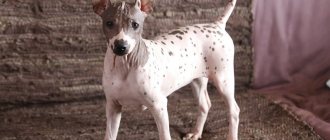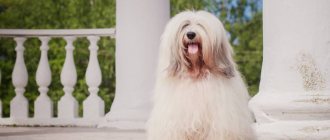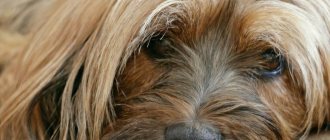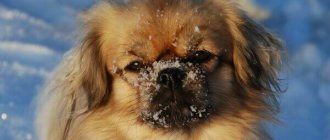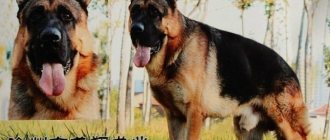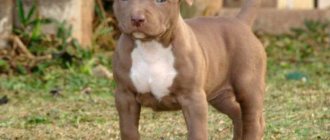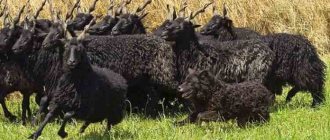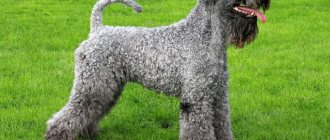- Dog breeds
The Tibetan Mastiff is a giant dog breed, one of the oldest dog breeds native to Tibet. In Tibet and throughout China it is considered a “sacred animal”. A dog of impressive size and the appearance of a lion with a steely character. The Tibetan Mastiff is strong, brave and has retained the wild habits of its ancestors. He is a fearless guard who will be the first to attack the enemy. They are aggressive towards strangers, but loyal to their owner and his family.
- Country of origin : China (Tibet)
- Height at withers : male: from 66 cm, female: from 61 cm
- Weight : male: from 60 kg, female: 50 kg
- Lifespan : 12-15 years
- Use : Security, Companion Dog
History of the breed
There is a legend that the Tibetan mastiff is the riding animal of the Enlightened Buddhas. The genetic age of the breed is very impressive and it is impossible to determine exactly. Many consider him the progenitor of all Molossians in Europe. The breed has retained its original appearance and protective qualities due to strict selection. They were always busy guarding the territory and the owner, warning of the approaching danger of an earthquake and avalanche. Dogs accompanied monks, protected merchants from robbers and lived in rich houses. The Tibetan Mastiff is valued all over the world due to the rarity of the breed and its qualities. Purebred Tibetans are valued very highly and are expensive.
Currently, in China, Tibetan mastiffs are kept in closed kennels under protection. It is very difficult to visit the nursery, but they are considered the best in the world.
Diseases and life expectancy
The average life expectancy of representatives of the breed is 12-14 years, which is an average. Proper care of your pet plays an important role. Lhaso Apsos are susceptible to a number of diseases:
- Ocular. The fur on the face constantly hangs over the eyes. Although long eyelashes perform a protective function, inflammatory processes are not uncommon.
- Kidney. A characteristic feature of many decorative breeds. Some kidney diseases are congenital, others are acquired due to improper maintenance, feeding, or colds.
Other diseases are less common. Sometimes puppies develop allergies at a young age, often food allergies. Apsos can also suffer from colds in cold weather.
Tibetan Mastiff: features of the breed
- One of the largest dogs in the world . Before purchasing, make sure you are ready to keep and care for such a large dog.
- Long walks . The dog is hardy and tolerates low temperatures well. You need to walk at least 2-3 hours a day.
- For experienced owners . Although the dog has a calm character, it is very capricious and needs control over its behavior while growing up.
- Challenging behavior . This is due to late maturation: males are formed by 4 years, females by 2-3 years. Bitches usually come into heat once a year.
- Aggressive . A dog can be aggressive if there is no training and early socialization.
- Excellent security guards . The dog only defends its territory. Reacts instantly to any signs of danger. The dog fearlessly attacks the enemy, even if he is superior in strength and size.
- Independent . Dogs behave independently of their owner.
Where to buy and price
The average price of representatives of the breed is from 40 to 120 thousand rubles. Finding a cattery in Russia is difficult; Lhasa Apsos are not common in our area. Sometimes offers appear on the websites of nurseries “AVGIT”, “Hangshan”, and others. Most admirers of the breed order puppies abroad.
The Lhasa Apso is a beautiful dog that looks luxurious thanks to its fur coat and charming face. However, this is not the kind of decorative pet that will sit in your arms for hours. Representatives of the breed are active, cheerful, and attached to their owner. Dogs are great for living in an apartment if they are properly maintained.
Care and maintenance
- Swim only in the warm season if necessary.
- Brush weekly.
- Trim nails once every 2 months.
- Dental care. It is enough to examine the teeth and oral cavity of the Tibetan Mastiff once a week. As for the care itself, during a thorough examination you should pay attention to: The condition of the gums - if they are red and inflamed, it is recommended to contact a veterinarian who will recommend special medications or remedies;
- Teeth color – ideally, it should remain normal, without plaque (you can clean it yourself) and purulent formations. To maintain teeth in good condition, special bones and toothpastes for dogs can be very useful;
- Dental health – check for loose or broken teeth. Between them there should also be no food residues, the accumulation of which causes the animal to develop an unpleasant odor from the mouth and subsequently rot;
- The presence of tartar - in this case, it is impossible to do without the intervention of a veterinarian and its removal. It should also be noted that an important factor for the health of the Tibetan Mastiff - and in particular teeth - is proper balanced nutrition.
Remember that all dog grooming procedures help to establish a relationship with the dog and train him to be disciplined. Regular checking of a Tibetan Mastiff puppy will develop into a kind of obligatory and pleasant communication procedure. If you notice any changes in behavior or find any unexplained sores or redness, contact your veterinarian.
Health
The dog is very healthy and not susceptible to any diseases. The most common problems are:
- Dysplasia of the hip and elbow joints.
- Rickets.
- Hypertrophy and dystrophy of bones.
- Osteochondritis.
- Panostitis.
Preventative measures to protect your Tibetan Mastiff puppy
- To keep your Tibetan Mastiff puppy completely safe, you first need to minimize his contact with unfamiliar dogs, especially strays. Therefore, you should not let your dog off the leash, as in this case it will become impossible to control its behavior and communication with other dogs. Since a dog can easily become infected with distemper from simply touching the nose of a sick animal. This disease can be transmitted to a dog through sniffing. Your dog can become infected with trichophytosis from contact with the lichen-affected fur of a sick dog. Naturally, it is impossible to completely exclude a dog’s communication with other dogs, since it must be socialized. Therefore, try to find friends with dog lovers who look after their animals. By adhering to this rule, you can eliminate the risk of pathogen transmission by 80%.
- You should walk your dog in places where there are no landfills. Since garbage very often attracts rodents, which in turn are very often carriers of various infections. Gray rats are especially dangerous because they carry such a serious disease as leptospirosis.
- You should not allow your dog to sniff other people's feces, as they are a source of worms.
- Monitor the well-being of your Tibetan Mastiff. Pay attention to even the most minor changes in his behavior. For example, your dog may appear lethargic, lose his appetite, or have a dry nose. Or you may notice that the dog begins to shed, and this has nothing to do with seasonal shedding. If hair loss becomes excessive, this is the first symptom indicating health problems in your pet. And only you can help him. Therefore, it is important to take the dog to the veterinary clinic in time, where the disease can be overcome for sure. In no case should you ignore the symptoms, since advanced infections are much more difficult to treat, and sometimes even impossible. If you start treating your dog, the disease can lead to his death or he will develop serious complications that will affect his hearing, vision, limbs and much more.
Characteristics and description of the breed
Height at withers: 25-28 cm,
Weight: 4-7 kg.
Acceptable color:
- sand;
- honey;
- gold;
- smoky;
- dark gray with gray streaks;
- black;
- party color;
- white;
- brown.
Additional characteristics: a small dog with long and thick hair that flows smoothly from the body to the surface of the floor.
The Apso has a well-balanced, strong body. The head is covered with voluminous hair that covers the eyes. The muzzle is straight, about 4 cm long, decorated with a rich mustache and beard. The ears droop and have long, thick hair, reminiscent of a woman's hairstyle with straight hair.
The eyes of the Lhasa Apso are dark in color, expressive, with long eyelashes. Please note that the white of the eye should not be visible from either the top or bottom of the eyeball.
The paws are straight, parallel to each other, overgrown, and the high-set tail looks like a “plume” due to the long hair hanging from it. The dog's movements are light and free.
Training and education
Poorly trained. The dog is freedom-loving and willful, which is why it is difficult to train. Tibetan mastiffs are not trained, but only educated and corrected behavior.
It is necessary to raise a puppy from the first days of its arrival in the house . Puppies grow quickly and can already weigh 20 kg at 3 months; an ill-mannered teenager can bring a lot of problems.
Submitting a dog doesn't always work. The principle of complete submission of the Tibetan Mastiff to the owner is an outdated method. This theory was formulated based on observations of packs of wild wolves, but they were kept in captivity and, of course, experienced stress. The stress condition forced wolves to show aggression towards each other, but in the wild they do not show aggression to each other - they live together and interact with each other. You need to perceive yourself as the more experienced and mature member of the pack, who is responsible for guiding the new member (Tibetan Mastiff puppy) and teaching him good behavior, as well as correcting him if necessary. It is important to remember that Tibetan Mastiff puppies learn a lot on their own. They are very inquisitive, love to explore new territories and, of course, experiment. Puppies tend to repeat actions they enjoy (like playing with a toy). They do not repeat actions that cause them pain (for example, destroying a nest and getting bitten). If your Tibetan Mastiff puppy misbehaves, ignore him and praise him when he does the right thing. Reward your puppy for following commands and good behavior. Do not neglect these tips. After all, constantly hearing “you can’t” all day long is unbearable. This is a small child who wants to know everything and get his portion of treats as a reward for not eating your favorite rug, going to the toilet outside, bringing you a ball, and so on.
Set rules and monitor their implementation
It is worth enrolling your Tibetan Mastiff puppy in obedience training classes. These classes will allow you to understand exactly what actions will allow you to control your dog’s behavior. You will be able to spend more time with your puppy, establish contact and socialize around other dogs.
Adviсe
- Training a Tibetan Mastiff puppy should be done with the help of positive motivation; watch carefully special films about this technique. The Canine Translator film series from National Geographic is suitable.
- If you need to leave your puppy at home alone for 2 hours or more, then ask someone to come to him.
- Be sure to make an appointment with your Tibetan Mastiff puppy to see your veterinarian as soon as possible. The doctor will carefully examine him and give him vaccinations that will protect him from dangerous diseases.
Attitude towards children and pets
They behave calmly with other dogs, but with proper early socialization . React appropriately to aggression from other dogs.
They treat children well . Dogs take care of all small family members. You don't have to worry about your child.
If you decide to get a dog, especially a puppy, then get ready for the following: you will often have to clean up little mistakes after the puppy; investments will be required in annual vaccinations, feeding, toys, ammunition, etc.; any animal requires attention and communication, so if you don’t have time, then there will be no mutual understanding with the Tibetan Mastiff puppy. Big changes are coming in your life. If you can handle this, you will find a loyal friend for life.
Character traits
If your choice falls on a pet originally from Tibet, then you should carefully study its character. In addition to being friendly and sociable, the Lhasa Apso is capable of being independent and showing character . The dog treats children and their pranks patiently, but nothing more - she will definitely not become their playmate.
In general, this small shaggy dog is distinguished by his prudence and calmness, which makes him an excellent companion. He loves, but does not stick, cannot bear long separations and loneliness, he, however, will not lie at your feet all the time. A cozy chair, leisurely walks - this is your leisure time with the Tibetan tailed philosopher.
The Lhasa Apso confirms the truth that appearances can be deceiving. Despite its poise and somewhat clumsy appearance, this dog has excellent hearing, scent, as well as a loud voice and wariness towards strangers. This is an excellent watchman and even a guide . All of the above combinations of qualities and characteristics make this dog ideal for older people, as well as for those who are inclined to a contemplative lifestyle.
Did you know? Another name for the Tibetan Apso breed is “seismograph dog.” By barking loudly, they are able to warn not only about strangers approaching their home, but also about approaching natural disasters.


